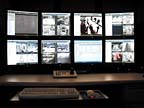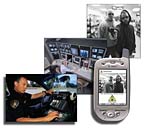
IP-based security video, a major technology trend seen at this year’s International Security Conferences and on the exhibit floor at the American Society for Industrial Security event, calls for new types of transceivers, often with the ability to select data rates. One example: Ethernet transceivers from such sources as International Fiber Systems IFS of Newtown, Conn. One of the IFS devices can transmit either 10Mps or 100Mbps Ethernet data 2 over multimode or single mode optical fiber ports or electrical via a RJ45 Ethernet cable port. The approach also plays to the convergence of security and IT.
Then there are the transceivers, switches and hubs that control and move security video over fiber optic, coax and unshielded telephone wires.
Update on compression
Compression plays a huge role in the quality, cost and effectiveness of a digital video security system. With the cost of digital storage still relatively high, compressing video can save an end user money on storage. But does it affect video quality?There are two types of compression in the digital video world. Lossless compression allows the original data to be reconstructed exactly from the compressed data, while lossy compression loses certain elements of the original product.
Lossy compression is what the video surveillance world uses, as lossless compression tends to require huge amounts of storage space and a lot higher resolution not required for most surveillance applications.
- Joint Photographic Experts Group (JPEG)
- Wavelet
- Motion Picture Experts Group (MPEG)
- Intra Frame (I Frame): The I frame is the only full frame of uncompressed information.
- Bi-linear frame (B Frame): The B frames look back and compare the current position of objects with the present position and then holds the information that has changed.
- Preceding Frame (P Frame): The P frames look back to tie the whole sequence together.
H-261, H-263
Originally designed for video telephony and conferencing over the Internet to give excellent frame rates over narrow bandwidth, H-26x uses JPEG-like compression with motion compensating prediction. Once an object is established as moving, the compression factor recreates the object in future positions where it predicts it’s going to be. It does not record the differences; rather, it moves the object forward and refreshes the background.
The advantage: it produces very small file sizes – in the range of 0.5 to 9kb. The downside: it doesn’t handle sudden or fast movements very well, as they throw off the prediction process.
Conclusion
Which one is better? Each has strengths and weaknesses but, in general, MPEG and H-26x are far better all-around compression types than their counterparts. Both MPEG and H-26x provide excellent transmission over the Internet due to their smaller file sizes, yet still retain excellent picture quality.About the Source
This material is from a Tips report from Sentry Security Systems Inc., Kingston, Ontario. Visit www.sentry-resellers.com.<

Sidebar: Open Remote Monitoring
Now there’s a unique remote monitoring and control solution that allows security professionals, law enforcement personnel and first responders to remotely access, monitor and control security systems from virtually any manufacturer using any computer or handheld device such as a cellular phone, PDA or tablet. From AirVisual, the open and secure platform offers full telemetry enabling control over internal functions such as PTZ control, DVR set-up and programming and access control with advanced notification features – including the ability to send bookmarks with specific information related to alarm events.AirVisual’s product suite is comprised of three remote applications: IntelliViewer – a wireless video monitoring platform; TransViewer – a mobile vehicle surveillance solution; and RoadViewer – a wireless traffic information system. IntelliViewer is a hosted software application that enables video surveillance (live and achieved video in real-time), access control and security systems to be accessed, monitored and controlled using any networked or mobile device. The remote solution delivers full telemetry to control internal functions such as PTZ operation or DVR programming via a secure network connection.
TransViewer is wireless and delivers real-time images from the inside of a vehicle, multiplexes and records up to eight video cameras and two channels of audio. The system can also respond to panic alarms and processes GPS information. RoadViewer alleviates many of the problems first responders experience due to everyday traffic by providing them a realtime view of traffic conditions. The system captures live video images from traffic camera networks and sends them along with alerts or other text-based information to wireless devices.
Sidebar: Untwisting Twisted Pair
In the arena of security video transmission, there’s coaxial cable, of course. But advances in technology have recently made transmission of unshielded twisted pair (UTP) more attractive.Providence Alaska Medical Center, for example, uses Network Video Technologies NVT (Menlo Park, Calif.) equipment to transmit security video signals from cameras to monitors via UTP. As the state’s largest medical facility, with more than 340 beds, Providence needed a cost-effective method to transmit video. “Primarily, the hospital wanted to be able to view the garage cameras from the main building control room,” said Bobby Alston, electronics design manager for Simplex Grinnell, which performed the installation. “The project cost a lot less by using UTP as opposed to coax.
“We installed a 100-pair Category 3 cable from the garage to the main building,” Alston explains. “Once in the building, we punched down the cable and ran the video signals to the NVT NV-1662R active receiver hubs, and then into Vicon DVRs.”
.jpg?height=200&t=1670387394&width=200)